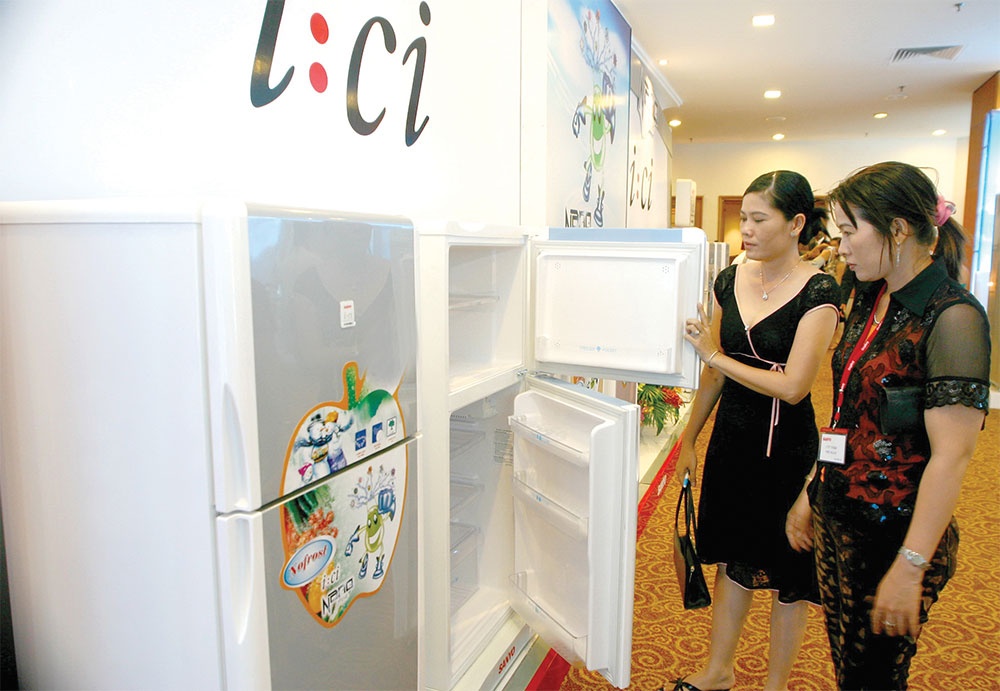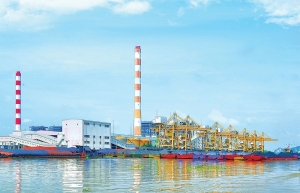Next stage on horizon for HCFC phase-out
 |
| Most consumers of HCFCs are in the informal sectors |
At last week’s closing workshop on Vietnam’s phase-out management plan for hydrochlorofluorocarbons (HCFCs), Tang The Cuong, director general of the Department of Climate Change under the Ministry of Natural Resources and Environment, highlighted some of the implementation results of the Montreal Protocol on substances that deplete the ozone layer in Vietnam.
“Stage II of the plan (HPMP2), covering the past five years, has phased out almost 1,660 tonnes of HCFCs and nearly 2.3 million tonnes of carbon, equivalent to about 444,300 homes’ electricity use for one year, and 1.16 million tonnes of coal burned,” declared Cuong.
Specifically, 11 businesses have carried out technology conversion, phased out the use of HCFC-22 and HCFC-141b in polyol; conducted training for technicians in maintenance and repair of refrigeration equipment and air conditioning; and offered good practice principles when working with HCFCs using flammable refrigerants.
The project has completed 10 technology conversion subprojects in refrigeration equipment manufacturing, foam production, air conditioner manufacturing, and more.
In insulation, foam production using HCFC-141b in pre-blended polyol with many chemicals that used to affect the ozone layer, foreign-invested enterprise Yantai Moon Vietnam has received $417,000 in assistance from the HPMP programme for new production lines. The company has already renovated the old machinery system, upgraded the safety warning system, and no longer used chemicals in the list of state-managed chemicals.
Suo Hongtao, general director at Yantai Moon Vietnam, said, “The insulation foam production lines have been converted to using cyclopentane instead of HCFC-141b. When participating in this initiative, we realised the practical social significance and received financial support to minimise harm to the surrounding environment during the production process.”
Tonmat Group participated in the Stage I project and completely converted to not using HCFC-141b in foam production. During this period, with the support of the project, Vietnam Green Material One-Member Co., Ltd. under Tonmat Group completed the establishment of a blending house for HCFC pre-blended in polyol, pioneering in providing, a blowing agent for foam production.
Tran Van Son, chairman and CEO at Tonmat Group, said, “As more people use it, the price is lower, and now the cyclopetane that we have been using since 2012, almost all of Vietnam has used it and the price has decreased to the same level as the previous blowing agent 141b.”
Nguyen Duy Minh, deputy general director at Tan A Dai Thanh Industrial Corporation, said, “With the support of the project, we have converted to new technology using cyclopentane. During the implementation process, we also encountered many difficulties. Fortunately, with the support of relevant counterparts and suppliers, the subproject has now been completed and put into use.”
Raising awareness
In manufacturing air conditioners and refrigerators, numerous businesses have been supported to convert from HCFCs to friendly materials. Southern Refrigeration Engineering has already converted technology to using ammonia in the production of refrigeration equipment.
Dinh Hoang Chuong, deputy director at Southern Refrigeration Engineering, said, “During the implementation of the project, we have had many advantages helping us take very long steps in phasing out HCFC in Vietnam, and our products are considered to have high performance and competitive prices with products from other countries in the region.”
Huynh Nhat Vu, deputy director at Saigon Refrigeration Engineering, said, “Together with our company’s capital, we have now changed the technological process, switching to using substances that do not affect the environment. Currently, our products use substances that do not affect the environment and still meet the quality requirements of customers.”
Nagakawa Group JSC received funding support from the project, converting the entire air conditioning production line using HCFC-22 gas to using HFC-32 gas, which is more climate-friendly, and training from Japanese experts on ensuring safety in the production, repair, and maintenance of air conditioners.
“We appreciate the HPMP2 project with support in capital, technologies, experience learned on building and operating factories, and training engineers. These are so useful for us to minimise mistakes and losses in manufacturing and operating,” said Tran Ba Dat, deputy general director at Nagakawa Group.
To date, the project has already trained and certified 350 customs officers on management of export and import of controlled substances; and trained 188 trainers from vocational and training schools on management and good practices in installation and servicing of refrigeration and air conditioning equipment.
Around 3,200 technicians working in the servicing sector have also been trained, over 100 types of training equipment have been handed over to vocational and training schools, and 300 toolkits have been delivered to servicing shops nationwide.
However, Nguyen Dang Thu Cuc, deputy director of the HPMP2 project, pointed out some issues. “In addition to numerous businesses that are ready to convert to environmentally friendly manufacturing, some are not ready to participate in technology conversion, and endure difficulty in showing proof of eligibility. Several surveyed enterprises changed business orientation or stopped production,” Cuc said.
During conversion, some manufacturers are struggling. Last year, Nagakawa Group broke ground for a factory in the northern province of Hung Yen’s Pho Noi A Industrial Zone with investment of $15 million to manufacture green products, along with costs to train sales agents and engineers, but these costs have yet to be included in the selling prices of goods.
“Furthermore, while product prices increase, consumers have yet to adapt and understand the environmental protection implications of new products and new technologies, it will take time to change consumer awareness. So the company has to solve two problems at the same time: retaining and levelling up consumer awareness,” Dat from Nagakawa Group told VIR. “If we make a product that consumers do not understand its meaning and effects, and do not buy, the business has no revenue to maintain production and development, and has no meaning in social life. Only consumers can determine the success of the green transition.”
Concentrating support
Ashraf El-Arini, task team leader of the HPMP2 project, said that analysis and projections indicate that demand for HCFCs in the servicing sector will exceed the maximum allowable limit as early as 2025 – the year that Vietnam must reduce consumption to 32.5 per cent of the baseline – by 400 tonnes.
“In 2030 when most HCFCs must be eliminated, leaving only 100 tonnes for the remaining decade, the demand is estimated to still be about eight times higher. This is despite the fact the new installed equipment will fall drastically because of government policy,” he said.
The Vietnamese government has decided that the proposed HPMP3 stage for 2024-2030 will be the final stage and address the two remaining reductions – 67.5 per cent reductions of the baseline in 2025 and 100 per cent reductions of the baseline in 2030.
“This extremely ambitious level of consumption reduction faces several challenges including that most of the HCFC consumers are service shops in the informal sectors for a range of applications, industrial refrigeration assembly and repair often using second-hand components continues, and the extent of HCFCs needed to meet the demand of installed equipment after 2030 is not known exactly but appears to be much more than allowed by the Montreal Protocol,” El-Arini added.
HPMP3 will therefore concentrate most support on the service sector and employ strategic actions like curbing future HCFC demand by banning manufacturing, assembly, and first charge of new installations of industrial refrigeration and central air conditioners; continue to strengthen customs capacity; and avoid illegal HCFC trade.
HPMP2 technician training will be upgraded to reach thousands of technicians across the country before the 97.5 per cent cuts in HCFCs, including with better use of incentives, El-Arini explained. Infrastructure and technician capacity will be improved to implement legislation on ozone depleting substances and greenhouse gas control, including new assessment standards, equipping training centres, promoting recovery and recycling, additional reclamation at designated facilities, and management of HCFC stocks for future years.
“We should ensure sustainable phaseout of HCFCs not recently imported or used for manufacturing with bans; continue to ensure sustainable phaseout across sectors; and change behaviour and mindsets surrounding HCFCs writ large, given that they will be eliminated,” El-Arini added.
 | Endorsements made for Vietnam’s COP28 pledges Vietnam has made a closer step towards international assistance for its energy transition by announcing its net-zero emission implementation plan on the grand stage of the COP28 climate summit. |
| As a member country implementing the Montreal Protocol on substances that deplete the ozone layer since 1994, Vietnam is obligated to phase out controlled substances according to the prescribed roadmap and receive support from the multilateral funds to implement this activity. The Department of Climate Change under the Ministry of Natural Resources and Environment is the implementing agency of the HPMP programme in Vietnam. During 2012-2017, Vietnam and the World Bank successfully implemented the HPMP1 to meet the obligation to phase out 10 per cent of the baseline consumption of HCFCs. During 2018-2023, the HPMP2 project is being carried out to phase out 35 per cent of the baseline consumption of HCFC. The HPMP2 project has provided financial and technical support to enterprises manufacturing air conditioners, refrigeration equipment, and foam for technology conversion without using HCFCs. |
What the stars mean:
★ Poor ★ ★ Promising ★★★ Good ★★★★ Very good ★★★★★ Exceptional
Related Contents
Latest News
More News
- Exports cement role as central pillar (January 09, 2026 | 12:37)
- Siemens and NVIDIA expand partnership to build industrial AI operating system (January 09, 2026 | 10:04)
- High targets, hard choices: companies weigh risks in 2026 (January 08, 2026 | 16:58)
- Murphy Oil Corporation achieves appraisal success at Hai Su Vang oil field (January 08, 2026 | 11:35)
- Nestlé Vietnam rolls out its 2026 Lunar New Year campaign (January 08, 2026 | 10:55)
- Acecook Vietnam: 30 years of creating happiness (January 08, 2026 | 08:00)
- Sustainability a core value for DKSH’s vision (January 07, 2026 | 16:00)
- People encouraged to contribute and grow at AstraZeneca Vietnam (January 07, 2026 | 15:48)
- Dat Bike accelerates sustainable mobility (January 07, 2026 | 15:24)
- Innovation to support modern healthcare development (January 07, 2026 | 10:00)

 Tag:
Tag:



















 Mobile Version
Mobile Version